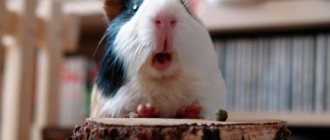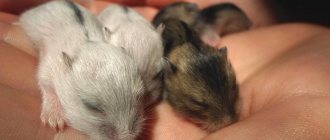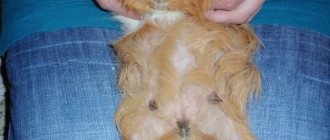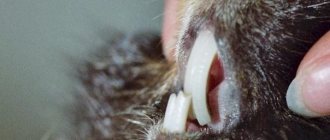When getting a British breed kitten, you need to take into account all the care needs of this breed. From the first days of life, it is necessary to monitor the weight of a British kitten month by month. This indicator is very important for their breed, because it is with its help that the healthy development of the baby is determined. Following the development of a British pet is very important and interesting. Monitoring body weight and height is necessary in order to identify the presence of pathologies at an early age.
First month
This period of a pet’s life is the most difficult. In the first days of life, it becomes clear how strong the cat's physique will be when he grows up, what weight he can reach. Scientists have experimentally proven that nutrition and care in early childhood determine the health of an animal in the future. If the baby did not eat well in the first days of life, this will most likely affect his weight in the future.
First days of life
Kittens of the British and Scottish breeds weigh relatively a lot. Adult animals of these breeds are quite large, but even kittens are born real heavyweights.
Newborn kittens weigh from 70 to 130, but by the second week of life they become almost 1.5 times heavier (110-150 g). The babies are still blind, inactive, sleep a lot and eat a lot.
During this period of development, you need to make sure that the mother receives enough vitamins (more than she herself needs), because kittens need good breast milk with a balanced set of nutrients.
Second week
Over the next few days, the British kitten gains weight and by the end of the second week its body weight should already be 210 grams. Normally, it can even reach 420 grams . At the same time, babies become more active and mobile, some “early” babies even open their eyes by the end of the second week.
Up to a month
From the third or fourth week (depending on the rate of development of the British cat), you can start feeding. But not all foods can be eaten by him - we recommend that you first read what to feed your Briton.
At the age of one month, kittens typically gain 250 grams of weight. Large, fast-growing babies can reach a maximum of half a kilogram, and this is quite normal.
Start of complementary feeding
The first dishes that can be given to a British baby are:
- crushed canned cat food;
- chopped boiled beef or chicken;
- boiled sea fish;
- cottage cheese;
- boiled egg yolk.
From the first days of complementary feeding, carefully observe how your baby eats and how he reacts to food. If you prefer to feed your pets food, you should not skimp on it, because as a result, this can provoke the development of urolithiasis.
With proper nutrition, warmth and care, by the beginning of the fifth week, a British kitten should weigh about 600 grams or even more . In a week, the kitten should gain about 100 grams more, and by two months its body weight will already be from 700 grams to 1.5 kg. This weight is not typical for all breeds, but only for the British and Scottish, which are considered to be quite large cats.
A table of the weight of a British kitten by month will also help you, which shows all the norms for this breed. It is recommended to keep a weight diary and use it to monitor the development of the Briton.
What does a British cat look like?
It is quite easy to distinguish a British cat from an ordinary cat.
It is always a “powerful”, squat and harmonious animal with rounded shapes. The chest of a large British cat looks wide, and the shoulders and back are massively dense, which is why the pet sometimes seems fat. The British cat has a smaller body shape, but with similar features. Fold-eared Briton - reality or myth>>
Mating, pregnancy, birth of British breed cats >>
Representatives of the breed can also be identified by their relatively muscular and short legs, which have a slightly rounded shape. The tail of British cats resembles a conical shape with a rounded tip.
The most easily recognizable characteristics of the British are their expressive face and plush coat.
The face of a British cat always has well-developed cheeks, which are often called sideburns. The general description of the facial expression of British cats includes a benevolent, friendly look and a natural “smile” like the Cheshire Cat from “Alice in Wonderland.” The main advantage of these pets is their velvet-plush fur, in which your hands sink. Regardless of whether the Briton is a shorthaired or longhaired dog, his coat should have a springy, fine texture and a fluffy undercoat. Types of British >>
In order to choose the right purebred, elite Briton, we recommend that you study in advance the distinctive features of the breed, its standard and seek help from a felinological organization that will provide you with the addresses of worthy nurseries.
Why does a British cat have a hanging belly?
Many owners of British breed cats often notice a saggy belly on their pet. And, naturally, they ask the question: “Isn’t this dangerous for health?” So, this is not a reason to panic at all. This is how British cat physiology works, and not only that! Even mongrel cats often have droopy bellies, just in a less pronounced form.
A fat tail is not a flaw in the exterior; experienced experts at exhibitions do not even pay attention to it. The only period when a British cat's belly disappears is during feeding, after which it appears again. Therefore, in no case should you cut down on the animal’s nutritional intake, since a thin British cat has a much larger fat fold. The British dog must look “appetizing” so that all its rounded shapes are clearly expressed, and then the pouch on the belly will only decorate the pet.
The pet is three months old
Watching how a Briton grows and develops is very interesting. But this is also useful, because sometimes it allows us to identify pathologies at an early stage of development. And for breeders, this is also a way to track the purity of the genetic line and keep their pet at an ideal weight for exhibitions and competitions.
If you fed him correctly, a kitten at 3 months weighs from 1 kg. The normal weight of a British cat is 1-1.5 kg. For males this figure is 1.5-2 kg.
The kittens are already quite large, and every day they can gain 100 grams, thus becoming even more massive. This is good for the development and normal weight of the British dog, because adult animals can reach 8 kg in weight.
British kittens aged 3 months © shutterstock
It is important that at this age your pet eats a balanced diet. If he has not yet been weaned off his mother's milk, the amount of vitamins in his mother's food needs to be increased, and the feeding should become more varied.
Which food to choose
At this age, owners must decide what they will continue to feed their pet. Watch what a British person eats with great pleasure. If you choose store-bought food, give preference to good food, which can cost a lot. An excellent option is the products of the American company Hills. Also high-quality food from such manufacturers as Innova EVO and Orijen.
If you decide to stick to natural food, it’s worth remembering the foods that you should never give to a British breed pet:
- all types of river fish;
- pork meat;
- smoked sausages and other “human” food;
- fermented milk products with a high fat content (sour cream, cream, etc.);
- chicken meat with bones.
Characteristics of British cats
The British Shorthair cat is valued not only for its cuteness and intelligent, kind look. This “fur” miracle has a calm temperament and good health.
The British are great for business people who spend most of their lives at work.
Pets love to retire for long periods of time so that no one disturbs their sweet sleep. However, this characteristic of a cat being like a teddy bear does not mean that it can be treated like a toy. The Briton will never allow his dignity to be humiliated.
Character and habits of British cats >>
Many owners complain that cats of this breed are unsociable and rarely allow them to be cuddled. But this does not mean that they do not show their love and affection for their owner. It's just that British cats are more restrained in expressing their feelings and are quite self-sufficient, unlike other breeds.
But information about the aristocratic behavior of a Briton from an early age pleases any “cat person.” After all, these pets are very clean and will never allow themselves to relieve themselves in the wrong place. In addition, British cats love to take care of their appearance on their own - they can spend half of their active time on licking and washing themselves in order to always look respectable and radiate charm and charm!
Four month old kittens
Kittens at 4 months are already quite large and look like smaller copies of adults. Weight of a British kitten at 4 months:
You have already convinced yourself that you have chosen a fairly large breed. The body of four-month-old pets becomes more prominent, the body structure becomes more muscular and squat. The weight of an animal depends not only on nutrition, but also on heredity, therefore, starting from this age, body weight fluctuates within fairly large limits - almost up to 2 kg.
If the British dog weighs more than 4 kg, this may be a signal that he is overeating, and it is time to reduce the portion of food and add an additional meal, evenly distributing the daily portion into several.
If the deviations for the cat’s age are serious, this is a reason to contact a veterinarian. A specialist can prescribe a special diet and a complex of essential vitamins.
What kind of hair do British cats have?
Special attention should be paid to British wool. Thanks to the harsh living conditions in the past, these animals have acquired an excellent coat with a very dense and thick undercoat. Despite the fact that the structure of the wool itself is thin, it feels quite elastic and soft to the touch. Therefore, representatives of this breed are often called plush. In addition, the coat of British cats is distinguished by beautiful, shiny colors. British cat care and maintenance >>
At the moment, there are about 60 colors that the British have. It can be any solid color, smoky, tortoiseshell, tabby, chinchilla, bicolor or colorpoint. The most common among them are solid blue, as well as two-color tabby and chinchilla.
Important! The British Shorthair's coat should be the same length all over the body. As a rule, it does not exceed 2.4 cm.
A healthy British cat never develops tufts of fur, so he can easily take care of his coat on his own.
Why is it important to control your pet's weight?
Monitoring the monthly weight of a British kitten is important because it helps to monitor the proper development of the pet. It is difficult to control development correctly based on some external geometric factors, so weight was taken as a basis.
In the first weeks, it is recommended to weigh kittens on an electronic scale every day, at a later age - once a week. Even newborns need to be weighed, and the minimum weight limit for them is 60 grams . If it is less, you should consult a veterinarian, and then take extra care with your baby.
Kittens are weighed at the same time to avoid possible inaccuracies. Babies gain about 10 grams of weight before a month, and later – 100 grams per week. If you observe irregularities, this may mean that the British person is not receiving normal nutrition.
Source
Tips for maintaining normal weight
To keep a British cat's weight within normal limits, owners need to maintain a balanced diet:
- add a small percentage of cereals and vegetables to dry and soft food;
- add boiled vegetables to the food (various varieties of cabbage, beets);
- meat and fish should only be lean, they should be included in the menu daily;
- Among the cereal products, it is best to give your cat oatmeal, millet, and rice;
- You need to cook porridge for your pet in water, without adding sugar and salt.
A kitten is taught to eat cereals and vegetables from an early age. The diet of an adult British cat should consist of 10–15% vegetables and cereals, 85–90% meat and fish.
Also, we must not forget about regular physical activity. To prevent a cat from developing obesity, the owner must engage it in active games every day.
High-quality and balanced nutrition, an abundance of vitamins and nutrients, an active lifestyle - these are the main factors for the full development of a British pet.
The owner should weigh the kitten at the same time every day in order to notice weight deviations in time. If the development of the “British” does not correspond to his age, then there is no need to hesitate in going to the veterinarian.
Source
Normal weight of kittens
Immediately after birth, based on the kitten’s build, you can understand what build it will be in the future and what size it will reach when it grows up.
Good care and good nutrition will have a great impact on the baby's development. But to find deviations in weight, you need to know the norms and regularly monitor them.
- Weight in the first days after birth. Newborns can weigh 70-130 g. By the second week, kittens gain 110-150 g. If the kitten weighs less, this may indicate that the nursing cat is not receiving the required amount of vitamins from food.
- Weight in the second week after birth. At this time, the weight can gain another 210 g on average. Activity appears, eyes may begin to open. According to the breed standard, a kitten in this period should weigh 420 g.
- Weight until the end of the first month after birth. At this time, the owner can begin to introduce complementary foods (boiled chopped chicken, beef, canned cat food, cottage cheese, boiled yolk), especially for babies with a large number of kittens in the litter. During this time, the “fluffy” should gain another 250 g. Under good conditions, its weight during this period can reach 500 g, at the beginning of the fifth week - 600 g, in two months - 700-1500 g.
- Weight until the end of the third month after birth. With proper care and nutrition, a kitten can weigh more than 1 kg by three months. Every day he gains 100 g. According to the norm, during this period the weight of a kitten on average reaches 1.5-2 kg for a cat and 1-1.5 kg for a cat. If during this period the kitten still receives mother's milk, it is necessary to ensure the supply of vitamins and provide a variety of complementary foods. You should not give kittens at this age natural pork, smoked meats, fatty dairy products, chicken with bones and river fish.
- Weight until the end of the fourth month after birth. By standards, kittens at this age weigh 1.7-2.4 kg (females), and males 2.1-3.9 kg. Now the kitten looks more like an adult animal. Depending on diet and heredity, a kitten can gain 2 kg. You need to take a closer look at a kitten weighing more than 4 kg: perhaps the amount of food can be reduced.
- Weight until the end of the fifth month after birth. By the beginning of the fifth month, a cat can weigh 2.2-2.9 kg, and a female cat can weigh 2.6-4.5 kg. Now the period of growing up begins, and by the time the kitten finally becomes an adult, the kitten will double its weight.
British kitten weight table by month
The weight of a British cat, as can be seen from the table, changes unevenly with age: the animal’s muscle and fat mass grows most rapidly in the first month, then slows down. At one year of age, the British pet actually reaches its maximum weight, and the weight stabilizes at 2.5 years.
| age | female, kg | male, kg | peculiarities |
| newborn | 0,07–0,15 | 0,08–0,15 | newborn kittens of the British breed are quite large |
| first week | 0,1–0,25 | 0,25–0,3 | a nursing cat needs to be well fed, food must be rich in vitamins and balanced, so that the cubs develop fully |
| second | 0,15–0,35 | 0,35–0,4 | by this time, British kittens should weigh approximately 1.5 times more than at birth, the eyelids of large and developed cubs open |
| third | 0,2–0,4 | 0,4–0,65 | you can gradually introduce complementary foods, especially if the litter is large and the kittens are weak |
| first month of life | 0,25–0,6 | 0,55–0,7 | as complementary food, they give boiled beef or chicken minced in a meat grinder or blender, sea fish fillet, soft canned cat food, cottage cheese, boiled yolk |
| 2 months | 0,45–0,9 | 1–1,7 | |
| 3 | 1–1,5 | 1,5–2,5 | if the cubs are still fed with mother's milk, then the feeding should be more balanced and rich in vitamins |
| 4 | 1,8–2,4 | 2,2–3,9 | |
| 5 | 2,2–2,9 | 2,6–4,3 | Before becoming an adult, a British kitten must gain the same number of kilograms as at 5 months of age |
| 6 | 2,3–3,6 | 3–5,4 | |
| 7 | 2,4–3,8 | 3,3–5,6 | |
| 8 | 2,5–4 | 3,5–6 | |
| 9 | 2,5–4,2 | 3,8–6,4 | |
| 10 | 2,5–4,3 | 4,1–6,6 | |
| 11 | 2,5–4,3 | 4,2–6,7 | |
| year | 2,5–4,5 | 4,5–7 | Once a British cat has become mature, it is prohibited to give fatty meats, smoked meats, fatty dairy products, river fish (they may contain helminths), bones (they are poorly digested in the stomach) |
How much should an adult British cat weigh?
You should not think that the weight of an adult British cat does not change. The weight indicators of mature individuals are insignificant, but still increase. Moreover, castrated individuals show a more rapid increase in body weight.
If a non-sterile one-year-old pet has an average weight of 4.5 kg, then a castrato weight norm is 3–6 kg for a female, 5–9 kg for a male.
NOTE! An adult British cat, provided it receives high-quality balanced food, gains weight by 50–100 g per day.
The table shows the normal weight of adult British cats and cats.
| age, years | female, kg | male, kg | height at withers, cm |
| 1 | 2–4 | 4–6 | 15–22 |
| 2 | 2,5–4,5 | 4,5–4,8 | 18–25 |
| 3 | 2,8–4,8 | 4,7–7 | 22–27 |
| 4 | 3,8–5 | 5–7,5 | 25–30 |
| 5 | 4–6 | 5,5–8 | 28–33 |
A healthy British cat should have a proportionate body. The ribs, pelvic and sternum bones should not protrude. The waist in the absence of obesity in British pets is clearly visible. The fat layer is moderate, through it you can feel the abdominal organs and chest.
INTERESTING! British cats with a solid coat color weigh on average more than their patterned counterparts. And this is the breed norm.
British breed standard
Do not forget that no matter how attractive a cat may be, in order to participate in the exhibition he must meet a certain standard.
The standard for each part of the body of a British cat is prescribed taking into account the requirements of the felinological organization in a special document.
WCF standard for British:
- Body. Squat, strong. Medium or large size.
- Head. Rounded, with a wide skull and short neck.
- Ears. Medium size, widely set, rounded.
- Nose. Small size, straight. On the line with the forehead it stands out with a small depression.
- Eyes. Moderately large, widely spaced. Any clearly defined color.
- Tail. Be sure to be short, fluffy at the base and rounded at the tip.
- Wool. Dense, thick, equal length. Has a well developed undercoat.
Other systems may have some differences in the standard, but generally are not very different from a WCF system.
If there are defects such as an elongated tail, thin paws, a body that is too short or a close-fitting coat texture, a British cat may be disqualified from the show. Therefore, to evaluate your pet, visit a special examination before the exhibition, where a specialist will explain in detail the pros and cons of the animal in accordance with the breed.
What are the dangers of being underweight?
In emaciated British cats, the ribs, sternum and pelvic bones protrude greatly, the limbs are thin, frail, and the stomach is sunken. Due to lack of nutrients, the hair sheds greatly. If you feel the sternum, there will be no fatty layer on the bones.
The most common reason that a kitten does not recover is a lack of mother's milk. This happens in a large litter, when not all cubs get their mother's nipple during feeding.
The owner must ensure that each kitten eats. If a cub lags behind its brothers in weight, then it needs to be moved more often to its mother’s nipples.
RECOMMENDATION! It happens that a mother cat’s milk disappears. In this case, kittens must be pipetted with high-fat, unsweetened concentrated milk.
If, despite all measures and efforts, the weight of the British kitten does not increase, then this is a signal of illness. The pet must be taken to the veterinary clinic immediately.
Sometimes owners note that in 8-9 month old British kittens the weight stays the same, or even drops slightly. There is no need to worry, the reason is hormonal changes in the body associated with puberty.
An adult cat's weight should not drop. In an exhausted animal, the functioning of internal organs is disrupted and mental disorders occur. The cat becomes nervous, anxious, and moves little.
The following problems may occur due to lack of weight:
- Violation of the body's thermoregulation. A British pet will feel cold, even if the temperature is comfortable. Cold weather becomes a real torment. The cat often catches a cold; at the end of autumn and winter it should not be allowed into the yard.
- Weakening of the immune system. Due to a deficiency of nutrients (especially proteins), antibody synthesis fails in the body. The cat becomes susceptible to inflammatory infectious diseases.
- Deterioration of the condition of the skin and coat. The fur becomes dull and the pet sheds profusely. Alopecia is often observed - the formation of bald patches in different parts of the body. The skin becomes dry and flaky.
- Reproductive dysfunction. In an exhausted animal, metabolism deteriorates, hormonal disruption occurs, which makes conception impossible. If the cat is already pregnant, she may have a miscarriage. Or the mother may devour the newborn cubs.
IMPORTANT! With a deficiency of vitamins, mineral elements and nutrients, British cats develop pancreatitis, cholelithiasis and urolithiasis, and defecation is impaired.
What are the dangers of obesity?
You can tell that a cat is obese by its sagging belly. Because the fat layer is too thick, the costal and vertebral bones cannot be felt. An obese animal moves slowly and ignores active activities.
ATTENTION! An obese cat needs to be examined at a veterinary clinic for prevention, as there is a high probability of developing diseases of the heart and vascular system, as well as inflammation of the joints.
Excess weight greatly affects the health of a British pet. The most common pathologies:
- increased blood pressure, development of atherosclerosis;
- lethargy, powerlessness, drowsiness;
- hormonal disbalance;
- blurred vision due to increased intraocular pressure;
- development of diabetes;
- the appearance of gout, osteoarthritis;
- disruption of the digestive tract;
- hard breath;
- thirst;
- deterioration of metabolism;
- weakening of the immune system.











